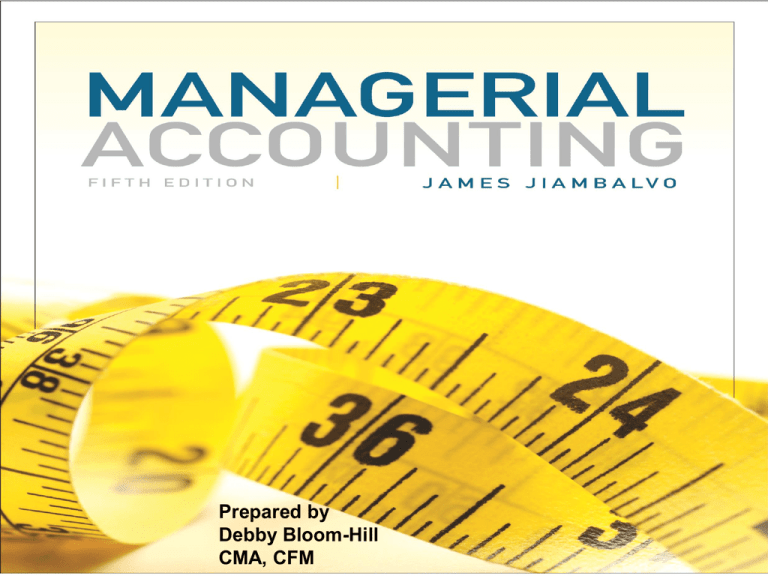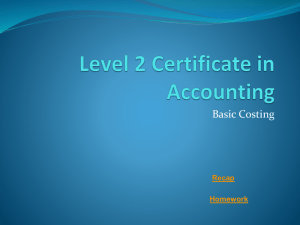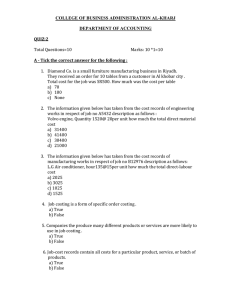
Prepared by
Debby Bloom-Hill
CMA, CFM
CHAPTER 5
Variable Costing
Slide 5-2
Full (Absorption) Costing
Required by GAAP for external reporting
purposes
Inventory costs include:
Direct materials used
Direct labor incurred
Generally variable
Manufacturing overhead
Slide 5-3
Generally variable
Includes both fixed and variable costs
Learning objective 1: Explain the difference
between full (absorption) and variable costing
Variable Costing
Inventory costs includes:
Direct materials used
Direct labor incurred
Variable manufacturing overhead
Fixed manufacturing overhead treated
as a period cost
Helpful for internal decision making
Not allowed for GAAP reporting
Slide 5-4
Learning objective 1: Explain the difference
between full (absorption) and variable costing
Which of the following complies with GAAP
for external reporting purposes?
a. Absolute costing
b. Variable costing
c. Fixed costing
d. Full costing
Answer:
d. Full costing, also known as
absorption costing
Slide 5-5
Learning objective 1: Explain the difference
between full (absorption) and variable costing
Full (Absorption) Costing
Slide 5-6
Learning objective 1: Explain the difference
between full (absorption) and variable costing
Variable Costing
Slide 5-7
Learning objective 1: Explain the difference
between full (absorption) and variable costing
Difference Between Full and
Variable Costing
The only difference between full and
variable costing is their treatment of
fixed manufacturing overhead
Under full costing, fixed manufacturing
overhead is included in inventory
These costs enter into the determination of
expense only when the inventory is sold
Under variable costing, fixed
manufacturing overhead becomes a
period expense
Slide 5-8
Learning objective 1: Explain the difference
between full (absorption) and variable costing
Variable Costing Income
Statement
Classifies all expenses in terms of their
cost behavior, either fixed or variable
With variable and fixed expenses
separated, the contribution margin can be
presented
Contribution margin is revenues minus total
variable expenses
The contribution margin allows users to
make reasonable estimates of how much
profit will change with changes in sales
Slide 5-9
Learning objective 2: Prepare an
income statement using variable costing.
Variable Costing Income
Statement
Sales are $100,000 and contribution
margin is $65,000
Calculate the contribution margin ratio:
𝐜𝐨𝐧𝐭𝐫𝐢𝐛𝐮𝐭𝐢𝐨𝐧 𝐦𝐚𝐫𝐠𝐢𝐧
$𝟔𝟓, 𝟎𝟎𝟎
=
= 𝟎. 𝟔𝟓 𝐨𝐫 𝟔𝟓%
𝐬𝐚𝐥𝐞𝐬
$𝟏𝟎𝟎, 𝟎𝟎𝟎
Calculate the change in contribution
margin if sales change by $10,000
$10,000 * 0.65 = $6,500
Slide 5-10
Learning objective 2: Prepare an
income statement using variable costing.
Variable Costing Income
Statement Example
Slide 5-11
Learning objective 2: Prepare an
income statement using variable costing.
Full Costing Income Statement
Example
Slide 5-12
Learning objective 2: Prepare an
income statement using variable costing.
Variable Costing vs. Full
Costing Income Statement
The full costing income statement
cannot be used to estimate the increase
in profit due to an increase in sales
The reason is that cost of goods sold
includes both fixed and variable costs
The fixed costs will not increase when
sales increase
Under full costing we do not know how
much of cost of goods sold is fixed or
variable
Slide 5-13
Learning objective 2: Prepare an
income statement using variable costing.
Example - Clausen Tube
Selling price $2,000
Variable costs (per unit):
Materials = $600/unit
Labor = $225/unit
Variable mfg. overhead = $75/unit
Variable selling expense = $40/unit
Fixed mfg. overhead = $1,200,000
Production = 5,000 units
Slide 5-14
Learning objective 3: Discuss the effect of
production on full and variable costing income.
Clausen Tube
Full Cost per Unit
Full cost per unit for 5,000 units is
calculated as follows:
Total Material Costs
$600 per unit
Total labor costs
$225 per unit
$75 per unit
Total variable OH
Fixed Overhead
Full Cost per Unit
Slide 5-15
$1,200,000/5,000
units
$240 per unit
= $1,140 per unit
Learning objective 3: Discuss the effect of
production on full and variable costing income.
Clausen Tube
Variable Cost per Unit
Variable cost per unit for 5,000 units is
calculated as follows:
Total Material Costs
$600 per unit
Total labor costs
$225 per unit
Total variable OH
Variable Cost per Unit
Slide 5-16
$75 per unit
= $900 per unit
Learning objective 3: Discuss the effect of
production on full and variable costing income.
Clausen Tube – Income
Statement
Selling price = $2,000/unit
Full cost = $1,140/unit
Variable cost = $900/unit
Variable selling expense = $40/unit
Fixed overhead = $1,200,000
Fixed selling expense = $100,000
Fixed administrative expense= $500,000
Slide 5-17
Learning objective 3: Discuss the effect of
production on full and variable costing income.
Clausen Tube – Income
Statements
Production equals sales (5,000 units)
Full Cost
5,000 x $2,000 =
5,000 x $1,140 =
Sales
Cost of goods sold
Gross margin
Selling & Admin Expenses*
Net Income
*100,000 + 500,000 + (5,000 x $40)
10,000,000
5,700,000
4,300,000
800,000
3,500,000
Variable Cost
Sales
5,000 x $2,000 =
10,000,000
5,000 * ($900 + $40)
Variable costs
4,700,000
Contribution margin
5,300,000
Fixed costs**
1,800,000
Net Income
3,500,000
**1,200,000 + 100,000 + 500,000
Slide 5-18
Learning objective 3: Discuss the effect of
production on full and variable costing income.
Quantity Produced Equals
Quantity Sold
When the quantity produced equals the
quantity sold, there is no difference
between net income calculated using full
cost versus variable costing
Since all units produced are sold, no fixed
cost ends up in ending inventory
The only difference is that variable costing
calculates the contribution margin
Slide 5-19
Learning objective 3: Discuss the effect of
production on full and variable costing income.
Clausen Tube – Income
Statements
Production (6,000 units) is greater than
sales (4,800 units)
Full Cost
4,800 x $2,000 =
4,800 x $1,100 =
Sales
Cost of goods sold
Gross margin
Selling & Admin Expenses*
Net Income
*100,000 + 500,000 + (4,800 x $40)
Variable Cost
4,800 x $2,000 =
4,800 * ($900 + $40)
Sales
Variable Costs
Contribution margin
Fixed Costs**
Net Income
**1,200,000 + 100,000 + 500,000
Slide 5-20
9,600,000
5,280,000
4,320,000
792,000
3,528,000
9,600,000
4,512,000
5,088,000
1,800,000
3,288,000
Learning objective 3: Discuss the effect of
production on full and variable costing income.
Quantity Produced is Greater
Than Quantity Sold
When the quantity produced is greater
than the quantity sold income will be
greater under full costing as opposed to
variable costing
Under full costing, inventory cost includes
fixed manufacturing overhead
Under variable costing, fixed
manufacturing overhead is a period cost
Slide 5-21
Learning objective 3: Discuss the effect of
production on full and variable costing income.
Clausen Tube – Income
Statements
Production (6,000 units) is less than sales
(7,200 units)
Full Cost
7,200 x $2,000 =
7,200 x $1,140 =
Sales
Cost of goods sold
Gross margin
Selling & Admin Expenses*
Net Income
*100,000 + 500,000 + (7,200 x 40)
14,400,000
7,920,000
6,480,000
888,000
5,592,000
Variable Cost
Sales
7,200 X 2,000 =
14,400,000
7,200 * ($900 + $40)
Variable costs
6,768,000
Contribution margin
7,632,000
Fixed costs**
1,800,000
Net Income
5,832,000
**1,200,000 + 100,000 + 500,000
Slide 5-22
Learning objective 3: Discuss the effect of
production on full and variable costing income.
Quantity Produced is Less
Than Quantity Sold
Then the quantity produced is less than the
quantity sold, income will be greater under
variable costing as opposed to full costing
Beginning inventory under fixed costing
includes fixed manufacturing overhead
When the beginning inventory is charged to
cost of goods sold the charge will be higher
under full costing
Slide 5-23
Learning objective 3: Discuss the effect of
production on full and variable costing income.
Variable Costing for External
Reporting
Slide 5-24
Learning objective 3: Discuss the effect of
production on full and variable costing income.
Summit Manufacturing, Inc. produces snow
shovels. The selling price is $25. Costs are:
Materials
Labor
Variable overhead
Fixed overhead
Variable selling & admin
Fixed selling & sdmin
Full cost per unit
4
3
2
168,000
1
152,000
Production is 42,000 snow shovels.
Calculate full cost per unit.
Slide 5-25
Learning objective 3: Discuss the effect of
production on full and variable costing income.
Summit Manufacturing, Inc. produces snow
shovels. The selling price is $25. Costs are:
Full Cost
Materials
Labor
Variable overhead
Fixed overhead
Variable selling & admin
Fixed selling & sdmin
Full cost per unit
4
3
2
168,000 168,000 / 42,000
1
152,000
4
3
2
4
13
Production is 42,000 snow shovels.
Full cost is $13 per unit.
Slide 5-26
Learning objective 3: Discuss the effect of
production on full and variable costing income.
Summit Manufacturing, Inc. produces snow
shovels. The selling price is $25. Costs are:
Materials
Labor
Variable overhead
Fixed overhead
Variable selling & admin
Fixed selling & sdmin
Full cost per unit
4
3
2
168,000
1
152,000
Production is 42,000 snow shovels.
Calculate variable cost per unit.
Slide 5-27
Learning objective 3: Discuss the effect of
production on full and variable costing income.
Summit Manufacturing, Inc. produces snow
shovels. The selling price is $25. Costs are:
Materials
Labor
Variable overhead
Fixed overhead
Variable selling & admin
Fixed selling & sdmin
Variable cost per unit
Variable Cost
4
4
3
3
2
2
168,000
1
152,000
9
Production is 42,000 snow shovels.
Variable cost is $9 per unit.
Slide 5-28
Learning objective 3: Discuss the effect of
production on full and variable costing income.
Impact of Method Selection on
Income Statement
Units produced = units sold
No difference in net income
Units produced greater than units sold
Full costing yields higher net income
Units Produced less than units sold
Variable costing yields higher net
income
Slide 5-29
Learning objective 3: Discuss the effect of
production on full and variable costing income.
Reducing Production
Slide 5-30
Learning objective 3: Discuss the effect of
production on full and variable costing income.
Kincade Faucets produces a variety of faucets.
During the year, the company incurred $400,000
of depreciation expense on its manufacturing
equipment. How much depreciation expense will
be in Finished Goods Inventory under variable
costing?
a.
b.
c.
d.
$400,000
$285,714
$0
None of the above
Answer:
a. Depreciation is a fixed cost which is expensed
as a period cost under variable costing
Slide 5-31
Learning objective 3: Discuss the effect of
production on full and variable costing income.
Impact of JIT on Income
Companies using JIT typically have low
levels of inventory
Units produced are approximately
equal to units sold
Difference between full costing and
variable costing is likely to be very
small.
Slide 5-32
Learning objective 4: Explain the impact of JIT on the
difference between full and variable costing income
Benefits of Variable Costing for
Internal Reporting
Variable costing facilitates costvolume-profit (CVP) analysis
Separates fixed and variable costs
Allows managers to accurately
estimate the impact of changes in
volume on cost and profit
Cannot be answered using full costing
Slide 5-33
Learning objective 5: Discuss the benefits of
variable costing for internal reporting purposes
Benefits of Variable Costing for
Internal Reporting
Variable costing limits management of
earnings via production volume
Managers are often compensated based
on income in their division
Full costing produces higher income
when production is greater than sales
Managers have an incentive to manage
earnings under full costing
Slide 5-34
Learning objective 5: Discuss the benefits of
variable costing for internal reporting purposes
Impact of Changes in Sales
Slide 5-35
Learning objective 5: Discuss the benefits of
variable costing for internal reporting purposes
Copyright
© 2010 John Wiley & Sons, Inc. All rights
reserved. Reproduction or translation of this
work beyond that permitted in Section 117 of the
1976 United States Copyright Act without the
express written permission of the copyright
owner is unlawful. Request for further
information should be addressed to the
Permissions Department, John Wiley & Sons,
Inc. The purchaser may make back-up copies for
his/her own use only and not for distribution or
resale. The Publisher assumes no responsibility
for errors, omissions, or damages, caused by the
use of these programs or from the use of the
information contained herein.
Slide 5-36





